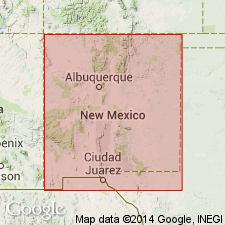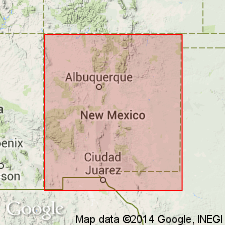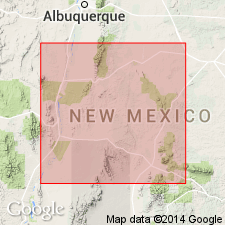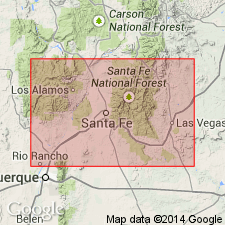
- Usage in publication:
-
- Anton Chico Formation
- Modifications:
-
- Named
- Dominant lithology:
-
- Conglomerate
- Sandstone
- AAPG geologic province:
-
- Palo Duro basin
Summary:
Named for the town of Anton Chico, northwest Guadalupe Co, NM. Type section designated and measured in NW1/4 NW1/4 NW1/4 sec 29, T12N, R17E, 0.7 km north of Anton Chico, San Miguel Co, NM in Palo Duro basin. Replaces former designation lower sandstone member of Santa Rosa Formation. Disconformably overlies Permian Bernal Formation and disconformably underlies Tecolotito Member (new) of Santa Rosa at type. Consists predominantly of red-brown to gray-red, very fine to medium-grained, well-rounded, moderately to poorly sorted, noncalcareous to calcareous sandstone, minor amounts of red-brown and gray-green silty mudstone, and conglomerate of medium-grained, poorly sorted, well-rounded clasts of siltstone in a litharenite matrix. Conglomerate present in two beds, one at base of formation at type. Is 22.1 m thick at type. Present along Pecos River at least as far south as Santa Rosa. Subsurface extent not known. Correlation charts. Correlative with Holbrook Member, Moenkopi Formation. Of Anisian, Middle Triassic age.
Source: GNU records (USGS DDS-6; Denver GNULEX).

- Usage in publication:
-
- Anton Chico Member
- Modifications:
-
- Revised
- Areal extent
- AAPG geologic province:
-
- Palo Duro basin
- San Juan basin
Summary:
Reduced in stratigraphic rank from formation to member of Moenkopi Formation. Recognized as the basal Triassic unit from the Tucumcari basin which is part of the Palo Duro basin, NM, west to the Lucero uplift in T5N, R4W, Cibola Co, NM in the San Juan basin, where it grades laterally into the Holbrook and Wupatki? Members of the Moenkopi. Disconformably underlies Tecolotito Member of Santa Rosa Formation. Of Middle Triassic age. Nomenclature chart. Anton Chico Member, where it occurs, shown on chart as having exactly the same boundaries as the Moenkopi Formation.
Source: GNU records (USGS DDS-6; Denver GNULEX).

- Usage in publication:
-
- Anton Chico Member
- Modifications:
-
- Overview
- AAPG geologic province:
-
- San Juan basin
- Orogrande basin
Summary:
Anton Chico Member of Moenkopi Formation recognized in south-central NM where it disconformably overlies Permian rocks of the San Andres or Artesia Formations. A 1.) "paleoweathering profile", the mottled strata, or 2.) a nonweathered Moenkopi underlies rocks of the Chinle Group, or locally of the Dakota Group. Shown on correlation diagram as underlying the Shinarump Formation (of Chinle Group) in west-central and part of east-central NM, and as underlying the Santa Rosa Formation (of Chinle Group) in parts of south-central and east-central NM. Anton Chico is as much as 102 ft thick. Gray-red sandstone is the dominant lithology in this area. Most of the sandstones are very fine to fine grained, micaceous, trough cross-bedded or ripple laminated litharenites; a few are graywackes. Contains mostly fresh biotite implying a nearby volcanic source. Dips of crossbeds imply paleoflow to north and northwest. The mudstones and siltstones are gray-red. The conglomerates are composed of intrabasinal pebbles of siltstone, mudstone, and nodular calcrete. Readily distinguished from underlying Permian red beds. Triassic Moenkopi red beds are grayish red, devoid of gypsum, dominated by micaceous litharenites, and graywackes, and have intraformational conglomerates. Permian Artesia red beds are red-brown, gypsiferous, dominated by quartzose sandstones and siltstones that are rarely trough cross-bedded, massive, and laminar. Anton Chico identified in Carrizo Arroyo, Valencia Co., in Socorro and Lincoln Cos., NM in the San Juan and Orogrande basins. Of Anisian, Middle Triassic age. Cross section. Measured section.
Source: GNU records (USGS DDS-6; Denver GNULEX).

- Usage in publication:
-
- Anton Chico Member
- Modifications:
-
- Areal extent
- AAPG geologic province:
-
- San Juan basin
- Las Vegas-Raton basin
- Palo Duro basin
Summary:
Some rocks in north-central NM have been misidentified as Bernal Formation. Rocks at Ocate and LaCueva, Mora Co., Las Vegas-Raton basin, and at Hagan-Placitas and San Ysidro-Red Mesa, Sandoval Co., San Juan basin belong to Anton Chico Member of Moenkopi rather than Bernal. Section measured in sec. 36, T14N, R15E, San Miguel Co., Palo Duro basin is 50.5 ft. of Anton Chico, disconformably above Bernal [or Artesia], disconformably beneath mottled strata of Santa Rosa Formation, consists mostly of red to brown sandstone and conglomerate Moenkopi rocks are immature lithic quartz wackestone and lithic arenite. Many of the larger siltstone and limestone clasts were derived from the underlying Permian. Is separable from Permian by its coarser grain size, trough cross-bedded sandstone and conglomerate deposited in a low-to medium-energy fluvial environment in braided to slightly meandering streams during Middle Triassic, Anisian time. Term Bernal abandoned at other localities; name replaced by Artesia Formation.
Source: GNU records (USGS DDS-6; Denver GNULEX).
For more information, please contact Nancy Stamm, Geologic Names Committee Secretary.
Asterisk (*) indicates published by U.S. Geological Survey authors.
"No current usage" (†) implies that a name has been abandoned or has fallen into disuse. Former usage and, if known, replacement name given in parentheses ( ).
Slash (/) indicates name conflicts with nomenclatural guidelines (CSN, 1933; ACSN, 1961, 1970; NACSN, 1983, 2005, 2021). May be explained within brackets ([ ]).

